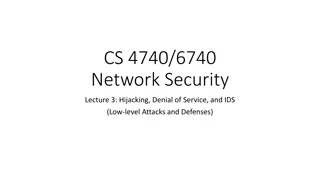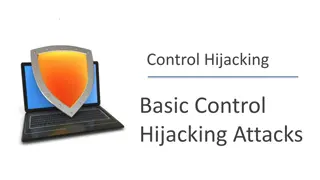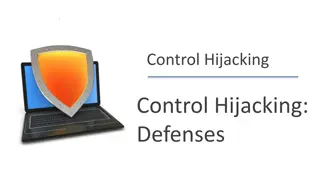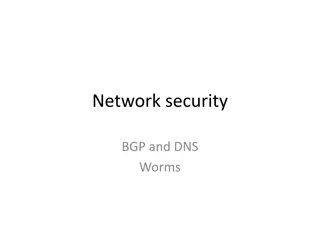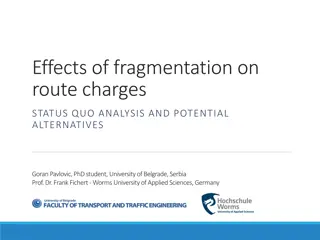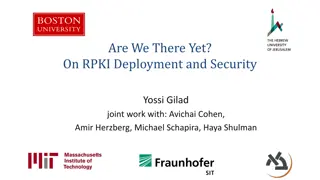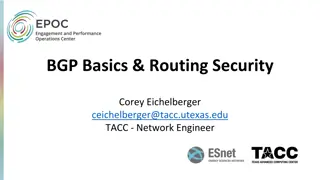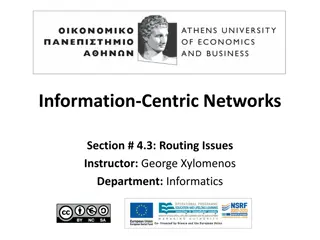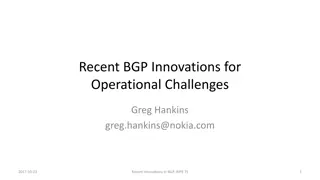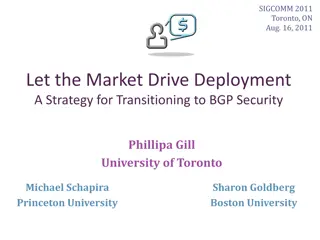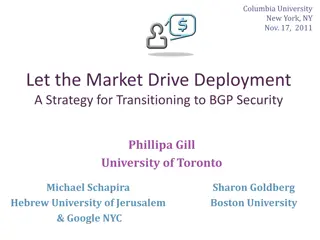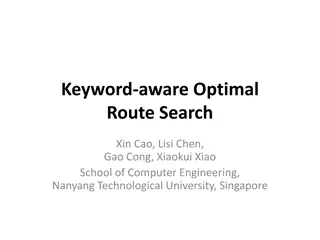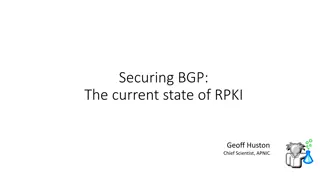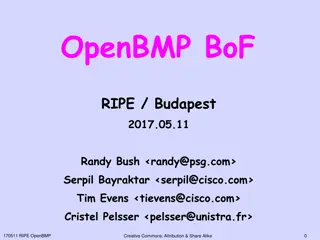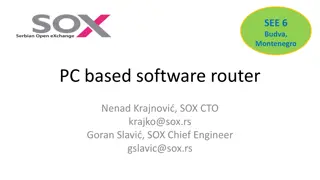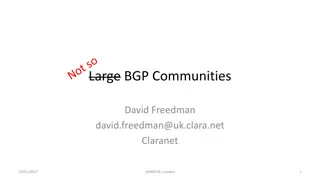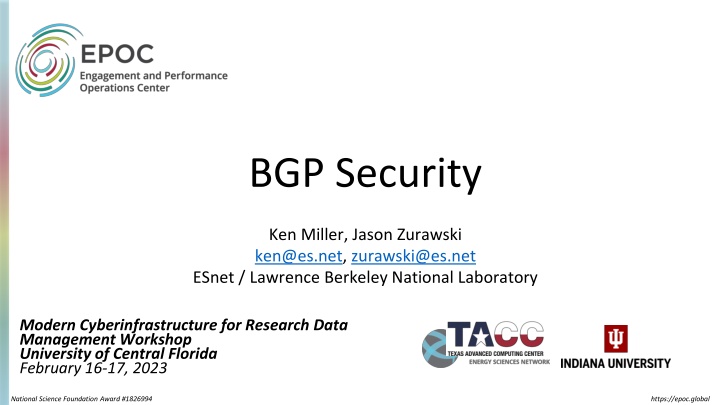
BGP Security and Route Hijacking
BGP, an old protocol since 1994, lacks built-in security measures, leading to risks such as hijacking, leaking, and spoofing. Route hijacking occurs when networks advertise routes without permission, potentially causing global disruptions. Learn about examples like the YouTube and Pakistan Telecom incident.
Download Presentation

Please find below an Image/Link to download the presentation.
The content on the website is provided AS IS for your information and personal use only. It may not be sold, licensed, or shared on other websites without obtaining consent from the author. If you encounter any issues during the download, it is possible that the publisher has removed the file from their server.
You are allowed to download the files provided on this website for personal or commercial use, subject to the condition that they are used lawfully. All files are the property of their respective owners.
The content on the website is provided AS IS for your information and personal use only. It may not be sold, licensed, or shared on other websites without obtaining consent from the author.
E N D
Presentation Transcript
BGP Security Ken Miller, Jason Zurawski ken@es.net, zurawski@es.net ESnet / Lawrence Berkeley National Laboratory Modern Cyberinfrastructure for Research Data Management Workshop University of Central Florida February 16-17, 2023 National Science Foundation Award #1826994 https://epoc.global
BGP is an OLD protocol Has been in use since 1994 https://datatracker.ietf.org/doc/html/rfc1654 Security was not a concern and not baked into the protocol Believes (without help) all advertisements from peers with no checks. It also by default can re-advertise to other peers what it learns. 2
Hijacking, Leaking, and spoofing MANRS reports over 10,000 routing outages or attacks in 2018* 40% of all incidents believed to be attacks. Incidents can quickly scale to global problems. 3 *https://www.manrs.org/2019/02/routing-security-getting-better-but-no-reason-to- rest/
Route / Prefix Hijacking When a network advertises/originates a route that belongs to another network (without permission) Not always malicious can easily be caused by misconfiguration 4 https://www.manrs.org/2020/09/what-is-bgp-prefix-hijacking-part-1/
Route / Prefix Hijacking - How it works AS Path length 5 https://www.manrs.org/2020/09/what-is-bgp-prefix-hijacking-part-1/
Example: Youtube and Pakistan Telecom Before, during and after Sunday, 24 February 2008: AS36561 (YouTube) announces 208.65.152.0/22. Sunday, 24 February 2008, 18:47 (UTC): AS17557 (Pakistan Telecom) starts announcing 208.65.153.0/24. AS3491 (PCCW Global) propagates the announcement. Routers around the world receive the announcement, and YouTube traffic is redirected to Pakistan. Sunday, 24 February 2008, 20:07 (UTC): YouTube changes to announcing two /24s. Some traffic starts going back to YouTube. 6 https://www.ripe.net/publications/news/industry-developments/youtube-hijacking- a-ripe-ncc-ris-case-study https://www.cnet.com/culture/how-pakistan-knocked-youtube-offline-and-how-to- make-sure-it-never-happens-again/
Example: Youtube and Pakistan Telecom 2 Sunday, 24 February 2008, 20:18 (UTC): AS36561 (YouTube) starts announcing 208.65.153.128/25 and 208.65.153.0/25. Because of the longest prefix match rule, every router that receives these announcements will send the traffic to YouTube. Sunday, 24 February 2008, 20:51 (UTC): All prefix announcements originated by AS17557 (Pakistan Telecom) via AS3491 (PCCW Global), are prepended by another 17557. The longer AS path means that more routers prefer the announcement originated by YouTube. Sunday, 24 February 2008, 21:01 (UTC): AS3491 (PCCW Global) withdraws all prefixes originated by AS17557 (Pakistan Telecom), thus stopping the hijack of 208.65.153.0/24. 7
Other Hijacking examples 2018: Amazon DNS routes hijacked and redirected to malicious DNS server: https://www.internetsociety.org/blog/2018/04/a mazons-route-53-bgp-hijack/ 2020: Rostelecom hijacks internet traffic for Google, AWS, Cloudflare, and others: https://www.zdnet.com/article/russian-telco- hijacks-internet-traffic-for-google-aws-cloudflare- and-others/ 8
Resource Public Key Infrastructure (RPKI) to the rescue (maybe?) Regional Internet Registries (RIR s) certifies owners of AS numbers and IP addresses. They also certify route announcements Route Origin Authorization (ROAs) show that you are authorized to advertise the IP addresses Allows you to verify addresses advertised to your router are authorized to be advertised by that entity Router can set the route as Valid, Invalid, or unknown Create route policy depending on those results Allows reject on wrong AS, wrong prefix, or too specific advertisement 9 https://www.noction.com/blog/rpki-overview
Route Leak RFC7908 - A route leak is the propagation of routing announcement(s) beyond their intended scope. A multihomed stub network announces routes from one upstream providers routes to one or more of its other upstream providers Stub network becomes an inadvertent transit provider. Only announce AS s and prefixes that you originate. 10 https://datatracker.ietf.org/doc/html/rfc7908
Simple Campus/Institution Route Leak Example X: AS5, AS1 X: AS4, AS5, AS1 AS5 AS4 X: AS2, AS4, AS5, AS1 X: AS1 AS1 AS2 X X: AS2, AS3, AS1 X: AS3, AS1 AS3 Stub network AS3 creates route leak advertising AS1 to AS2. 11
Route Leak Example 2017: Rostelecom Route Leak Targets E- Commerce Services: https://www.thousandeyes.com/blog/rostelecom -route-leak-targets-ecommerce-services Confirmation that traffic destined for those E- Commerce sites went through the leakers network (possible inspection?) 12
Route Policy to fix Leaks - Overview BGP Operations and Security RFC: https://datatracker.ietf.org/doc/html/rfc7454 Includes lots of great best practices for AS and prefix filtering Good Primer: https://www.noction.com/wp- content/uploads/2019/08/BGP-Filtering-Best-Practices.pdf 13
Route Policy to fix Leaks - Inbound Loose Inbound Filtering Highlights include: Don t accept your own prefixes from a peer. Filter Bogons (Addresses not assigned) IPv4 not so much anymore but IPv6 YES Be careful of more specific prefixes IPv4: more specific than a /24 IPv6: more specific than a /48 Strict Filtering: use scripts or tool to validate incoming prefixes against route registries. https://www.irr.net/ 14
Route Policy to fix Leaks - Outbound If you are a multihomed only advertise what you originate. Don t advertise private space (RFC1918) Prefixes used on your internal networks Default route 15
IP Spoofing Attacker creates and send IP packets with false source address Commonly used in Distributed Denial of Service (DDOS) attacks DNS, memcached, NTP, UDP - lots of vulnerabilities November 2021: Microsoft detects and mitigates a 3.47Tbps (340 million packets per second) 15 minute long DDOS attack using UDP reflection. 16 https://azure.microsoft.com/en-us/blog/azure-ddos-protection-2021-q3-and-q4-ddos-attack- trends/
Source Address Validation and IP Spoofing Unicast Reverse Path Forwarding (uRPF) Router checks it s forwarding information table (FIB) for source address in each packet. Strict: Source Address must be reachable via incoming interface (strict) or in the FIB (loose) or packet is dropped. Can be done with ACL s as well but can require a lot of manual configuration. Best Current Practices (BCP) 38 http://www.bcp38.info/index.php/Main_Page https://datatracker.ietf.org/doc/html/rfc2827 17 https://learn.nsrc.org/bgp/urpf https://blog.apnic.net/2022/02/07/source-address-validation-use-cases-and-gap- analysis/
BGPSec RPKI doesn t validate the entire ASPATH of a prefix. BGPSec intended to verify the full path. https://datatracker.ietf.org/doc/html/rfc8205 and more IETF working groups moving forward (https://datatracker.ietf.org/wg/sidrops/about/) No commercial implementations yet. few open source projects (https://github.com/usnistgov/NIST-BGP-SRx) 18
Takeaways! Routing will not take care of itself Old routes may not work well with new networks New routes may not work as planned How do we address routing anomalies as a community? The Routing Working Group!
How we used to solve this: I think I ve found a bad route. How do I address this? Start a conversation! Hello, it appears that there s a lot of traffic going between your institution and X that probably shouldn t Can we work together to improve it?"
What do we do now? Routing Working Group case process 1. Cases are submitted via the mailing list, slack or at the monthly meeting 2. Teams are selected to assist with the case by the chairs 3. The case is added to the master case list (open access) RWG Master Case List 4. A folder is created for the specific case and team members are given access to the documentation Most cases are worked on via email or slack 5. Case updates are given at each RWG meeting
Routing Working Group - What are the goals? Engineering focus Document possible erroneous routes Identify teams to address them Check in together as we work through them Policy Focus Detail routing policies for paths Including preferred backup paths! Verify if policy is being followed
Routing Challenges Weve Observed Asymmetrical routing - meaning a source to a destination takes one path and takes a different path when it returns to the source R&E data takes a less efficient route around the world - affecting performance Europe to Asia routes traversing the US Africa to Europe routes traversing the US R&E data takes a commodity route when an R&E path is available New R&E links are removed or added but routing does not adjust appropriately Leaking of Private ASN s into the global routing table by R&E networks IP blocks advertised with a Bogon Origin ASN s within R&E routing table
ITB <> Starlight Summary: Asymmetrical routing is preventing access the starlight ESnet DTN. Route from ITB to ESnet Chicago is using R&E networks via TEIN, TransPAC and Pacific Wave Chicago ESnet to ITB is using the PCCW and commercial paths. Resolution: Worked with ESnet to update accepted routes from TransPAC to use R&E path. Trace routes are symmetrical now, We received confirmation from ITB engineers that they are able to access the DTN. Team: Simon Peter Green (SingAREN) , Basuki Suhardiman (ITB) , Brenna Meade (IU)
Singapore to New Zealand Summary: Traffic from Singapore to New Zealand traversing the US, and is asymmetrical Resolution: Asymmetric routing has been resolved by moving traffic to the Singapore <> Guam link and confirmed via PS tests for both IPv4 and IPv6 Routes before changing the routing: SingAREN@SG -> SingAREN@LA - > Internet2@LA -> REANNZ SingAREN@SG -> APAN-JP -> Transpac@SEA -> REANNZ Current symmetrical routing (using Guam <> Singapore link) : SingAREN@SG -> GOREX-> REANNZ Team: Brenna Meade (IU) , Dylan Hall (REANNZ) , Francis Lee (SingAREN), Simon Green (SingAREN)
Taiwan to Indonesia Perfsonar tests indicate asymmetric routes Taiwan to Indonesia (16 hops) ASGCNET <> APAN <> SINET <> TEIN2 <> BANDUNG-NET Indonesia to Taiwan (11 hops) BANDUNG-NET <> TIEN2 <> ASGCNET Resolution: Peering was changed at ASGCNET to prefer BANDUNG-NET NetSage
Questions? Transfer Performance problems? EPOC is here to help! epoc@tacc.utexas.edu https://epoc.global/ NSF Award: 1826994
BGP Security Ken Miller, Jason Zurawski ken@es.net, zurawski@es.net ESnet / Lawrence Berkeley National Laboratory Modern Cyberinfrastructure for Research Data Management Workshop University of Central Florida February 16-17, 2023 National Science Foundation Award #1826994 https://epoc.global

